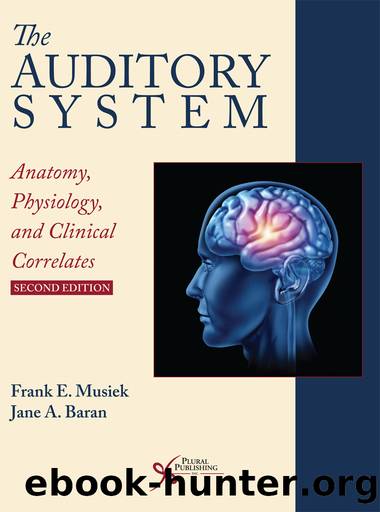The Auditory System: Anatomy, Physiology, and Clinical Correlates, Second Edition by Frank E. Musiek Jane A. Baran

Author:Frank E. Musiek, Jane A. Baran [Musiek, Frank E.]
Language: eng
Format: epub
Publisher: Plural Publishing Inc.
Published: 2018-07-15T00:00:00+00:00
A number of recent papers have raised questions as to the exact anatomical location of Heschl’s gyrus (Leonard, Puranik, Kuldau, & Lombardino, 1998; Penhune, Zatorre, MacDonald, & Evans, 1996; Schneider et al., 2002). Anatomical questions surrounding the location of Heschl’s gyrus concern variances in the number of gyri and the anatomical markers that define the anterior aspect of this structure (i.e., the anterior sulcus of Heschl’s gyrus, also termed the anterior temporal sulcus) and the posterior aspect (i.e., Heschl’s posterior sulcus, which separates Heschl’s gyrus from the planum temporale).
Heschl’s gyrus can be described as a relatively small gyrus that courses posteromedially along the STP, while the planum temporale is often shaped like a piece of pie (the crust is the lateral cortex and the pointed area is the medial cortex) that courses lateromedially. As just mentioned, the sulcus between Heschl’s gyrus and the planum temporale is sometimes referred to as Heschl’s posterior sulcus—a designation that appears to be appropriate. The identification of Heschl’s gyrus and the planum temporale is difficult at times because there can be more than one Heschl’s gyrus. When there is more than one gyrus, the division is noted by a small sulcus known as Beck’s intermedius sulcus or the sulcus intermedius. Two and even three Heschl’s gyri have been reported in some individuals (Campain & Minckler, 1976; Musiek & Reeves, 1990). In addition, asymmetries for the number of gyri on the left and right sides of the brain have also been reported (Campain & Minckler, 1976). Some studies have additionally shown an asymmetry in the size of Heschl’s gyrus between the two sides of the brain, with the left side being larger than the right, but other measurement techniques have yielded somewhat varying results (Campain & Minckler, 1976; Musiek & Reeves, 1990; Penhune et al., 1996; Rubens, 1977). Recent MRI-based information has indicated greater gray matter volume for Heschl’s gyrus on the left side than on the right side of the brain for most individuals (Rademacher et al., 2001). Interestingly, this has not been found to be the case for professional musicians, who tend to show more symmetry in the gray matter volumes for their right and left transverse gyri and additionally exhibit an overall greater volume of gray matter than do nonmusicians (Schneider et al., 2002). Finally, MRI studies have shown greater overall volume for the left primary auditory cortex compared with the right for most normal subjects (Penhune et al., 1996).
Download
This site does not store any files on its server. We only index and link to content provided by other sites. Please contact the content providers to delete copyright contents if any and email us, we'll remove relevant links or contents immediately.
When Breath Becomes Air by Paul Kalanithi(7255)
Why We Sleep: Unlocking the Power of Sleep and Dreams by Matthew Walker(5637)
Paper Towns by Green John(4164)
The Immortal Life of Henrietta Lacks by Rebecca Skloot(3820)
The Sports Rules Book by Human Kinetics(3581)
Dynamic Alignment Through Imagery by Eric Franklin(3482)
ACSM's Complete Guide to Fitness & Health by ACSM(3459)
Kaplan MCAT Organic Chemistry Review: Created for MCAT 2015 (Kaplan Test Prep) by Kaplan(3418)
Introduction to Kinesiology by Shirl J. Hoffman(3297)
Livewired by David Eagleman(3116)
The River of Consciousness by Oliver Sacks(2989)
Alchemy and Alchemists by C. J. S. Thompson(2908)
The Death of the Heart by Elizabeth Bowen(2896)
Descartes' Error by Antonio Damasio(2728)
Bad Pharma by Ben Goldacre(2722)
The Gene: An Intimate History by Siddhartha Mukherjee(2488)
Kaplan MCAT Behavioral Sciences Review: Created for MCAT 2015 (Kaplan Test Prep) by Kaplan(2485)
The Fate of Rome: Climate, Disease, and the End of an Empire (The Princeton History of the Ancient World) by Kyle Harper(2430)
The Emperor of All Maladies: A Biography of Cancer by Siddhartha Mukherjee(2427)
